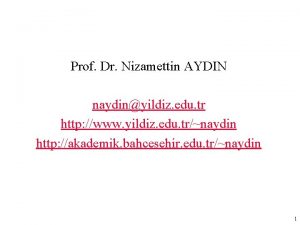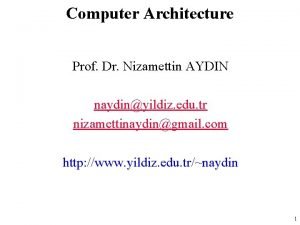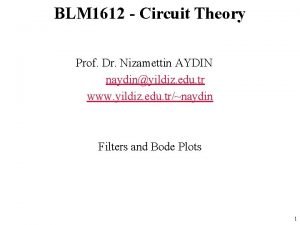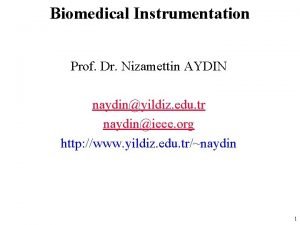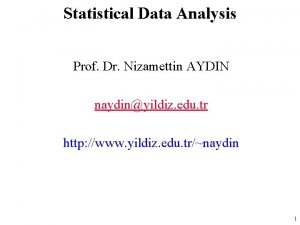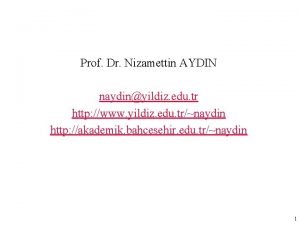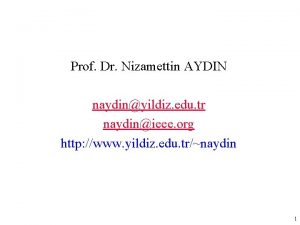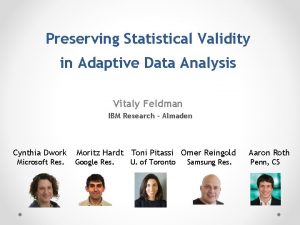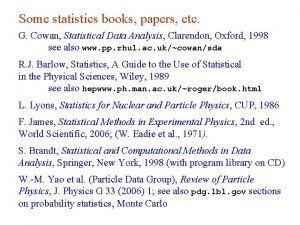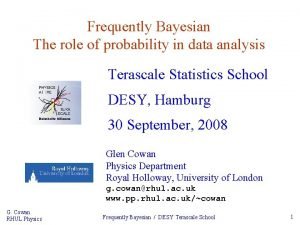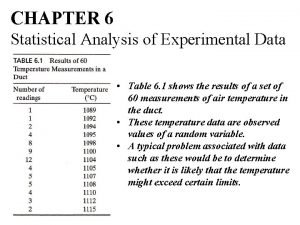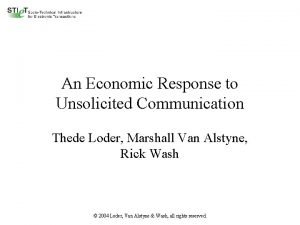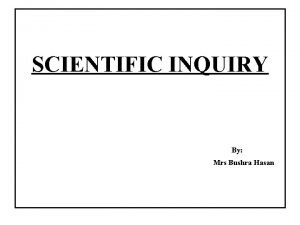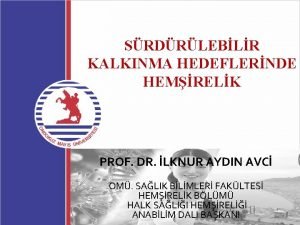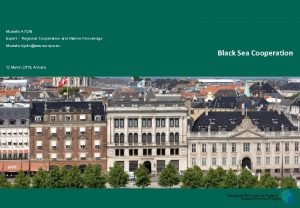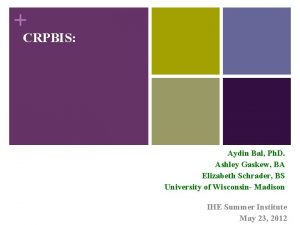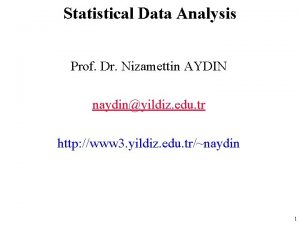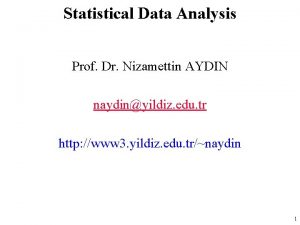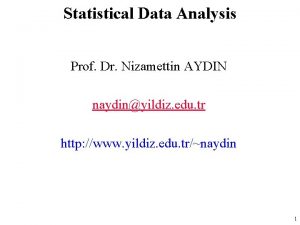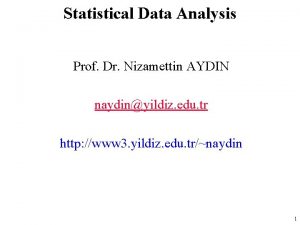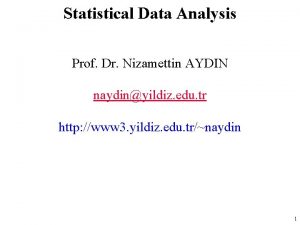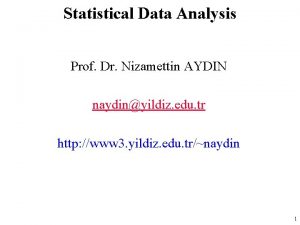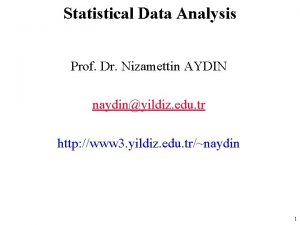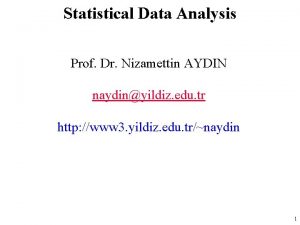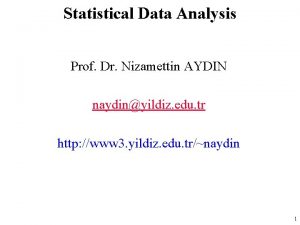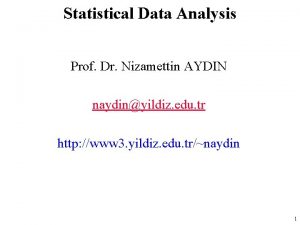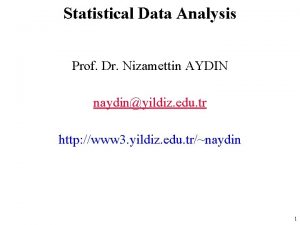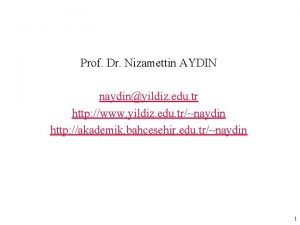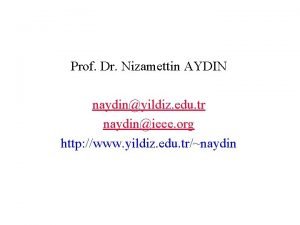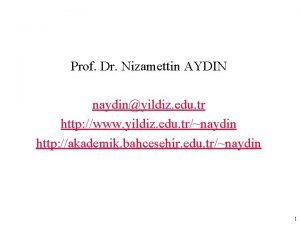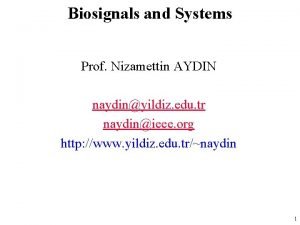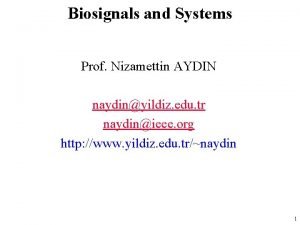Statistical Data Analysis Prof Dr Nizamettin AYDIN naydinyildiz





















- Slides: 21

Statistical Data Analysis Prof. Dr. Nizamettin AYDIN naydin@yildiz. edu. tr http: //www 3. yildiz. edu. tr/~naydin 1

Statistical Data Analysis Introduction 2

The role of statistical analysis in science • This course discusses some statistical methods, – which involve applying statistical methods to various problems such as biological, economics, social, health, etc. • We use empirical evidence to study populations and make informed decisions • To study a population, we measure a set of characteristics, – which are referred to as variables • The objective of many scientific studies is to learn about the variation of a specific characteristic in the population of interest 3

The role of statistical analysis in science • In many studies, we are interested in possible relationships among different variables. • We refer to the variables that are the main focus of our study as – the response (or target) variables. • In contrast, we call variables that explain or predict the variation in the response variable as – explanatory variables – predictors depending on the role of these variables. • Statistical analysis begins with a scientific problem usually presented in the form of – a hypothesis testing – a prediction problem. 4

Description of samples and populations • Statistics is about making statements about a population from data observed from a representative sample of the population. • A population – a collection of subjects whose properties are to be analyzed. – contains all subjects of interest. • A sample – a part of the population of interest – a subset selected by some means from the population. 5

Description of samples and populations • we sample subjects from a large population and use the information obtained from the sample to infer characteristics about the general population. 6

Description of samples and populations • A parameter – a numerical value that describes a characteristic of a population • A statistic – a numerical measurement that describes a characteristic of a sample • We use a statistic to infer something about a parameter. 7

Description of samples and populations • {For example, we are interested in the average height of a population of individuals. – The average height of the population, m, is a parameter, • but it would be too expensive and/or time-consuming to measure the height of all individuals in the population. – Instead we draw a random sample of, say, 12 individuals and measure the height of each of them. • The average of those 12 individuals in the sample is our statistic, – if the sample is representative of the population and the sample is sufficiently large, we have confidence in using the statistic as an estimate or guess of the true population parameter m. } 8

Description of samples and populations • The distinction between population and sample depends on the context and the type of inference that you wish to perform. – If we were to deduce the average height of the total population, then the 12 individuals are indeed a sample. – If for some reason we were only interested in the height of these 12 individuals, and had no intention to make further inferences beyond the 12, • then the 12 individuals themselves would constitute the population. 9

Sampling • The samples are selected randomly – i. e. , with some probability from the population. • Unless stated otherwise, these randomly selected members of populations are assumed to be independent. • The selected members are called sampling units. • The individual entities from which we collect information are called observation units, or simply observations. • Our sample must be representative of the population, and their environments should be comparable to that of the whole population. 10

Sampling • Some of the most widely used sampling designs – Simple Random Sampling • the chance of being selected is the same for any group of n members in the population – Stratified Sampling • The population is first partitioned into subpopulation and sampling is performed separately within each subpopulation • a. k. a. strata – Cluster Sampling • Group observations units into clusters and then sample from these clusters 11

Designing Studies • Once a research question is defined, the next step is designing a study in order to answer that question. • This amounts to figuring out what process you will use to get the data you need. • After obtaining the sample, the next step is gathering the relevant information from the selected members. • There are two major types of studies – observational studies – experiments 12

Observational studies and experiments • In observational studies, researchers are passive examiners, – trying to have the least impact on the data collection process. • Observational studies are quite helpful in detecting relationships among characteristics. • When studying the relationships between characteristics, it is important to distinguish between association and causality. – The realationship is casual if one characteristic influences the other one. • It is usually easier to establish causality by using experiments. – In experiments, researchers attempt to control the process as much as possible. – An experiment imposes one or more treatments on the participants in such a way that clear comparisons can be made. 13

Data exploration • After collecting data, the next step towards statistical inference and decision making is to perform data exploration, – which involves visualizing and summarizing the data. • The objective of data visualization is to obtain a high level understanding of the sample and their observed (measured) characteristics. • To make the data more manageable, we need to further reduce the amount of information in some meaningful ways so that we can focus on the key aspects of the data. – Summary statistics are used for this purpose. 14

Data exploration • Using data exploration techniques, we can learn about the distribution of a variable. – The distribution of a variable tells us • the possible values it can take, • the chance of observing those values, • how often we expect to see them in a random sample from the population. • Through data exploration, we might detect previously unknown patterns and relationships that are worth further investigation. – We can also identify possible data issues, such as unexpected or unusual measurements, known as outliers. 15

Statistical inference • We collect data on a sample from the population in order to learn about the whole population. – {For example, Mackowiak, et al. (1992) measure the normal body temperature for 148 people to learn about the normal body temperature for the entire population. • In this case, we say we are estimating the unknown population average. – However, the characteristics and relationships in the whole population remain unknown. • Therefore, there is always some uncertainty associated with our estimations. } 16

Statistical inference • The mathematical tool to address uncertainty in Statistics – probability. • The process of using the data to draw conclusions about the whole population, while acknowledging the extent of our uncertainty about our findings, is called statistical inference. • The knowledge we acquire from data through statistical inference allows us to make decisions with respect to the scientific problem that motivated our study and our data analysis. 17

Computation • We usually use computer programs to perform most of our statistical analysis and inference. • The computer programs commonly used for this purpose – – – – SAS, STATA, SPSS, MINITAB, MATLAB, R, Pyton, … • R is free and the most common software among statisticians • You are encouraged to learn R for additional flexibility in your data analysis.

Summary • The steps for performing statistical analysis of data. 19

Why statistics? • Reasons for using statistical data summary and analysis: – The real world is full of random events that cannot be described by exact mathematical expressions – Variability is a natural and normal characteristic of the natural world – We like to make decisions with some confidence. • This means that we need to find trends within the variability 20

Questions to address • There are several basic questions we hope to address when using numerical and graphical summary of data: – Can we differentiate between groups or populations? • probably the most frequent aim of biomedical research – Are there correlations between variables or populations? – Are processes under control? • Such a question may arise if there are tight controls on the manufacturing specifications for a medical device 21
 Prof. dr. nizamettin aydin
Prof. dr. nizamettin aydin Prof. dr. nizamettin aydin
Prof. dr. nizamettin aydin Prof. dr. nizamettin aydin
Prof. dr. nizamettin aydin Prof. dr. nizamettin aydin
Prof. dr. nizamettin aydin Nizamettin aydin
Nizamettin aydin Package diagram
Package diagram Mega giga tera
Mega giga tera Preserving statistical validity in adaptive data analysis
Preserving statistical validity in adaptive data analysis Cowan statistical data analysis pdf
Cowan statistical data analysis pdf Cowan statistical data analysis pdf
Cowan statistical data analysis pdf Statistical analysis of experimental data
Statistical analysis of experimental data Sinan aydın ymm
Sinan aydın ymm Aydın kendirci
Aydın kendirci Unsent message to aydin
Unsent message to aydin Sevil aydın
Sevil aydın Aydın bir türk kadınıyım
Aydın bir türk kadınıyım Bushra hasan
Bushra hasan Ilknur aydın avcı
Ilknur aydın avcı Aydin marine
Aydin marine Aydın başar
Aydın başar Nazmi aydın
Nazmi aydın Aydin bal
Aydin bal
